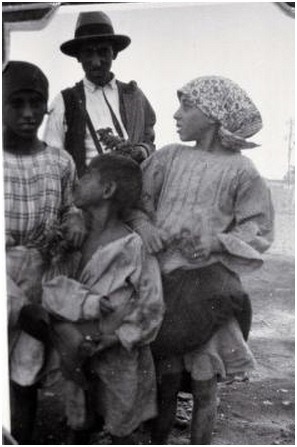By J.D. Arden, M.L.I.S., Reference Services Librarian, Genealogy Specialist, Center for Jewish History

Image: Street Scene [Bucharest]
Collection of Leo Baeck Institute
Wednesday, April 8th is International Romani Day,celebrating and raising awareness of the Romani people, an ethnic minority with
roots in Northern India who, like the Jewish people, experienced an expulsion
from their homeland hundreds of years ago, and began a subsequent diaspora
throughout the Middle East, Europe and the Americas. Throughout their history,
the Romani suffered much of the same discrimination and persecution as Jews
did. Many of the same stereotypes followed both groups in their frequent expulsions
and migrations through medieval Europe: allegations of stealing children, blood
libels, accusations of sorcery and usurious business dealings. Both Jews and
Roma were subjected at times to an additional tax in various medieval empires. Both
Jews and Roma were implicated, by religious fundamentalist rhetoric, in being
cursed for being responsible for the death of Jesus—in the case of the Roma, for
supposedly having manufactured the nails used in the Crucifixion.
The Roma (referred to in the past by the inaccurate and often
disparaging term “Gypsies”) were the other main ethnicity, alongside Jews, targeted
by the Nazi regime for annihilation in the death camps and in unmarked mass
graves. Many of the Romani and Jewish victims
perished, unaccounted for on the Eastern Front, in the wake of the Nazi
Einsatzgruppen mobile killing units. The Shoah Resource Center at Yad Vashem has preserved documents
detailing one of many such atrocities of this time. Efforts to document these
mass killing sites are being undertaken by organizations such as Yahad-In Unum which also works to collect testimony of Roma survivors.
In the library and archives of the Center for Jewish History,
the history and shared paths through national dispossession, migration and
survival of persecution and genocide are well represented in several languages.
In the catalog search.cjh.org, the search terms “Romanies” or
“Romany” yield over 70 catalog results. Other examples of ethnic groups
represented in the collections of CJH partner organizations are Armenians (over
60 catalog results), Kurds (over a dozen catalog results), and Druze (over 10
catalog results).
In the YIVO Institute for Jewish Research at CJH there is a
grammar book of the Romani language, explained in German, Die Sprache der
Transsilvanischen Zigeuner: Grammatik, Wörterbuch by Heinrich von
Wlislocki (1856-1907), published in 1884. According to Professor Yaron Matras
of the School of Arts, Languages, and Cultures at the University of Manchester,
author of The Romani Gypsies (2015) among other books, in some dialects
of the Romani language, the term for a Jew is “biboldo”, meaning without-baptism,
constructed from the Indic and modern Hindi prefix bi(n), without, and the Romani verb bold-, meaning
to turn over, hence to baptize. According to other sources, other Romani
dialects give “biboldo” the meaning of fresh or pure.
The journey of these nations through diaspora and
discrimination has not been clear or easy, yet the fact that the Center for
Jewish History exists and houses the cultural heritage of peoples who were
threatened with genocide is a testament to survival, resiliency and
perseverance. Sadly, recent events in Europe and elsewhere have shown that Jews
and Roma are still facing a shared battle against the rise of violent attacks,
riots, shootings, discrimination, and neo-fascist politics. The road of this
shared sorrow and shared survival is not easy–and although it seems not to be
over, we’ve survived it before.
___________________
A select bibliography of books at CJH related to Romani
history:
A History
of the Gypsies of Eastern Europe and Russia by David Crowe (1994, St.
Martin’s Press)
A Nikdo
Vám Nebude Věřit: Dokument o Koncentračním Táboře Lety u Písku [But
Nobody Will Believe You: a document about the Lety Concentration Camp] by
Markus Pape (1997,
GplusG)
Bury Me Standing:
the Gypsies and Their Journey by Isabel Fonseca (1995, Knopf)
____________________
Press Statement from U.S. Department of State regarding International Roma Day: http://www.state.gov/secretary/remarks/2015/04/240388.htm
News articles about International Roma Day:
Deutsche Welle, April 8, 2013 “International Roma Day”: http://www.dw.de/international-roma-day/a-16727421
Amnesty International, April 8, 2009 “International Roma Day: Europe’s Roma community still facing massive discrimination”: http://www.fightdiscrimination.eu/news-and-events/international-roma-day-europes-roma-community-still-facing-massive-discrimination
